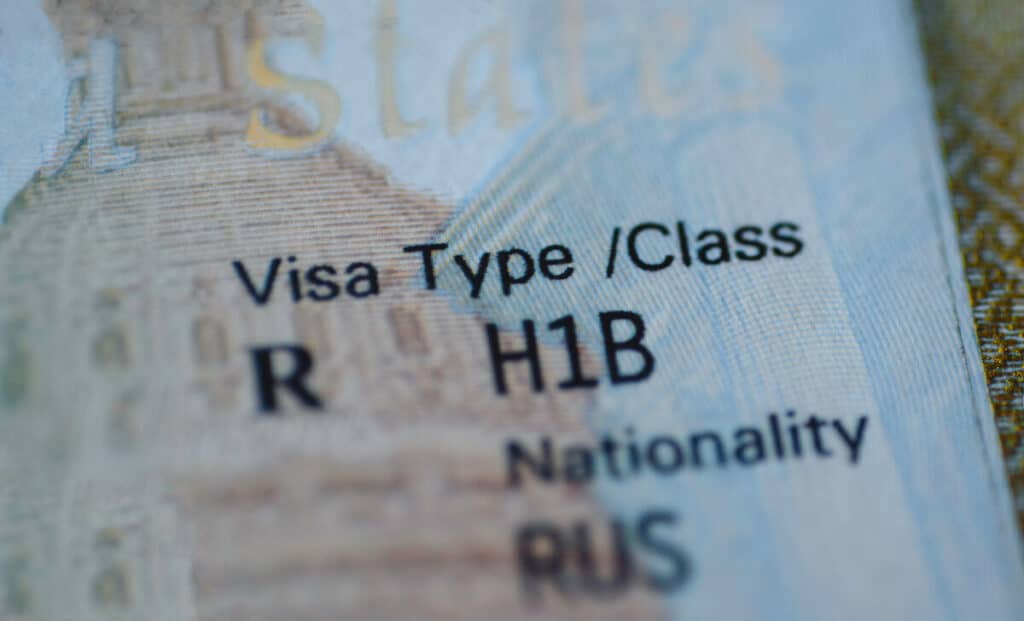Are you applying for an H-1B visa? Many of Remitly’s customers have come to the United States on an H-1B visa as foreign workers under the U.S.’s immigration laws.
Foreign workers seeking these visas need to know about the H-1B prevailing wage for their desired position. Prevailing wages are required under U.S. law to help ensure that employers treat all U.S. workers, including foreign workers, fairly.
Read on to find out more about the process and prevailing wage data. But first, an update.
Fiscal Year 2024 H-1B Update
USCIS received enough registrations for the fiscal year 2024 H-1B cap, including the master’s cap. A second selection round was held, and 77,600 registrations were randomly chosen as of July 31st, 2023. Selected registrants can file H-1B cap-subject petitions.
Finally, an upcoming H-1B modernization rule aims to reduce misuse and improve the registration process. For more details, visit the USCIS H-1B Specialty Occupations website.
What is the H-1B?

The H-1B is a nonimmigrant work visa program allowing U.S. employers to hire temporary, rather than perm (or permanent), workers. To qualify, workers need to be within a specialty occupation determined by the U.S. Department of Labor. They can also get a job that relates to Department of Defense cooperative research.
According to the U.S. Citizenship and Immigration Services (USCIS), a specialty occupation is a job position that requires highly specialized knowledge and requires at least a bachelor’s degree or an equivalent. Sometimes, you may need an official letter from your H-1B employer verifying your specialty.
The H-1B program assists employers who aren’t able to hire employees in the U.S. within a specific occupation. This employer-sponsored visa means an employer can offer a job to non-residents who want to work for them.
What is the H-1B prevailing wage rate?
The term “H-1B prevailing wage levels” refers to the average wage earned in a specific area by someone with a similar skill level and qualifications as the applicant.
Each kind of job will have its own prevailing wage. You can search the Foreign Labor Application Data Center or Bureau of Labor Statistics for data about jobs and their prevailing wages in the U.S.
Each type of job has four income levels. Of these, the fourth is the highest. Each level is based on the leadership, management skills, or seniority associated with each job. With increased responsibility, the prevailing wage goes up.
How do I find the H-1B prevailing wage?
Finding the prevailing wage is a great way to determine whether your employer will have a high chance of success in getting your H-1B visa approved.
Here’s how to find the H-1B prevailing wage for your role:
- Head to the Foreign Labor Certification Data Center website. (This website is also an excellent resource for occupational employment statistics and other information, so make sure you bookmark it for later.)
- Click on “Search Wizard” on the “Wage Library” tab for the online wage library.
- Choose the state where the job is located from the dropdown, and hit “Continue.”
- Enter as many job details as possible in the available fields, such as the county where the job is located and the job title, and hit “Search.”
- Check out the wage levels and average salaries within the specific geographic area you selected.
Once you have that information, compare it to the job for which you’ve applied.
The employer should also provide H-1B workers with detailed information that includes the H-1B wage level of the job. Look for the wage level for your intended position as well.
Why is the prevailing wage important?
The H-1B prevailing wage helps protect the job market in the U.S. Both the Department of Labor (DOL) and the USCIS work together to certify employment-based visas so that workers won’t fall victim to cheap labor practices.
That’s why the job position needs to pass a Labor Condition Application (LCA) test. The government wants to make sure that your position and salary won’t hurt American workers by “pricing them out” of the job market.
Who pays for H-1B prevailing wages?
Your employer pays your wages and the legal and processing fees associated with obtaining your H-1B visa.
The employer must pay the actual wage (i.e., the wage that it normally pays workers with the position) if higher than the prevailing wage to any foreign worker, according to the wage rule.
How are prevailing wages determined?
The H-1B prevailing wage is determined by the LCA, which is the first stage of the visa process. Employers need to submit the LCA to the Department of Labor. It needs to be certified before a petition to the USCIS furthers the application process.
The LCA specifies the details of the position. Details include where you’ll be working, years of experience necessary for the position, and the prevailing wage determination. Employers must also specify the effective date for the job.
The electronic review process may happen within minutes, depending on whether a human reviewer needs to look at the application.
What is the key requirement for an LCA approval?
Chief among the key requirements for the LCA is salary level. Although the wage level for your specific job position will determine your final salary, you can’t earn less than the prevailing wage for your job area.
H-1B visas are reserved for those with skills not readily available in the U.S., so the wage percentile (where it lies in the distribution of wages among similar positions) is also key.
The LCA won’t be approved if the offered salary is lower than the prevailing wage. For instance, a level one (or low) wage may not be convincing enough to suggest that a foreign national should be first in line.
Of course, this depends on the type of job and whether there is a shortage of skills in a certain geographic area.
Why should I care about the LCA?
To be successful, you need to ensure the employer offered you a wage level that supports the visa requirements, not just an entry-level wage.
Ask your employer if they’ve hired H-1B employees before. They should be familiar with the Office of Foreign Labor Certification. You may also need to be checked via the Department of Homeland Security to ensure eligibility.
When you’re applying for jobs, it’s not only the salary and other benefits you must consider, but also your chances of visa approval. Understanding and working through the details is the first step to making smart financial decisions for you and your family.
FAQ: The H-1B Visa
Read on for answers to common questions about the H-1B. Please note that immigration laws and regulations may change over time, so it’s essential to consult with a qualified immigration attorney or official government sources for the most up-to-date information on the H-1B visa program.
How long does the H-1B visa process typically take?
The H-1B visa process involves several steps, including Labor Condition Application (LCA) filing, USCIS petition submission, and visa stamping (if applicable). The processing times may vary depending on various factors, such as the volume of applications and USCIS processing times. On average, the entire process may take a few months.
Can I change employers on an H-1B visa?
Yes, you can change employers while on an H-1B visa. However, the new employer must file an H-1B transfer petition on your behalf before you start working for them. It’s crucial to maintain legal status during the transition, and the H-1B transfer process must be completed before leaving your current job.
Is there a minimum salary requirement for H-1B visa holders?
While there is no official minimum salary requirement set by the U.S. government for H-1B visa holders, the prevailing wage plays a significant role. Employers are required to pay the prevailing wage for the specific occupation and location where the H-1B visa holder will work. This wage is determined based on the job’s requirements and prevailing wages for similar positions in the area.
Can I apply for a Green Card (permanent residency) while on an H-1B visa?
Yes, H-1B visa holders are eligible to apply for a Green Card (permanent residency) in the United States. Many H-1B workers use their employment as a stepping stone to obtain permanent residency. The process involves employer sponsorship and navigating the complexities of the U.S. immigration system.
Are there any restrictions on H-1B visa holders’ job changes within the same company?
H-1B visa holders can change job roles or positions within the same company without losing their H-1B status. However, the new job must still meet the criteria of a specialty occupation and must be filed as an amended petition or a new H-1B petition with the USCIS.
Can my family members accompany me on an H-1B visa?
Yes, your spouse and unmarried children under 21 years old can accompany you to the U.S. on an H-4 visa. They can study in the U.S. but are not allowed to work unless they qualify for a separate work visa.
Is there a limit on the number of H-1B visas issued each year?
Yes, there is an annual cap on the number of H-1B visas issued each fiscal year. As of the latest update on July 31st, 2023, USCIS received enough registrations for the fiscal year 2024 H-1B cap, including the master’s cap. A second selection round was held, and 77,600 registrations were randomly chosen.
Does Canada have an H1B visa?
In Canada, the equivalent program is called the Temporary Foreign Worker Program (TFWP) and the International Mobility Program (IMP). These programs allow Canadian employers to hire foreign workers on a temporary basis when there is a genuine need for their skills and expertise and when it is difficult to find Canadian citizens or permanent residents to fill those positions.
For highly skilled workers, there are programs such as the Global Talent Stream, which facilitates the hiring of foreign workers with unique and specialized skills.
The H-1B Visa Holder Work Permit initiative is newly offered by the Government of Canada. This initiative was designed to retain highly skilled workers in North America and has recently reached its cap of 10,000 applications on July 17, 2023.
Under this policy, eligible individuals with a valid H-1B Specialty Occupations visa residing in the US had the opportunity to apply for an open work permit for up to 3 years. f you were among those who successfully applied, congratulations! Your work permit will remain valid for the duration of your passport, up to 3 years. It’s essential to note that if your passport expires before the 3-year period, your work permit will also expire at the same time. Although you can’t request an extension under this specific initiative, there might be other programs available for you to explore.
The good news is that this temporary policy will be active for one year or until the total of 10,000 applications is reached, whichever comes first. So, if you didn’t get a chance to apply this time, there might be future opportunities.

The bottom line
An employer needs to pay H-1B visa employees the prevailing wage. (Note that if the actual wage is higher, you need to be paid that amount.) You’ll be paid similarly to others working in the same company.
This process ensures that you’re being treated fairly, and protects the U.S. job market and economy at the same time. It helps prevent companies from taking advantage of foreign workers, or hiring them because they think those workers may accept less money than American workers.